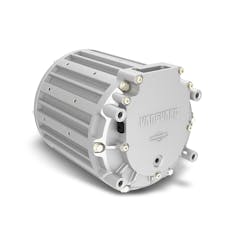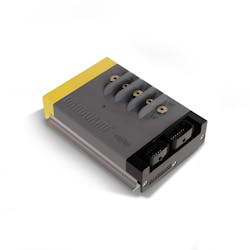Briggs & Stratton is expanding its Vanguard portfolio to include electric motors and motor controllers. This will enable the company to provide OEM customers with a full-system solution for their electric machine designs.
Available starting in 2024, OEM customers can select from different power options in the MVG Series Motors and MC Series Motor Controllers lineup to mee their varied machine voltage requirements. To start, the MVG Series will include the MVG1500, MVG2200, MVG3000 and MVG4000 Motors, and the MC Series the MC2000, MC4000 and MC8000 Motor Controllers.
The company announced the introduction of these products at The Battery Show 2023, an annual event focused on the design and manufacture of electric vehicle technologies. Companies like Briggs & Stratton have increased their presence at this event in recent years as they've become more involved in the electrification space; the show itself has grown too due the increasing number of exhibitors and attendees, demonstrating the significance of the move to electrified power systems and the ever-increasing need for more knowledge about the technologies involved.
Power & Motion spoke with Toby Canapa, Product Manager for Electrification for Vanguard, about the company's reasoning for adding the electric motors and motor controllers to its offering, and how they will benefit the industry's continued development of electrification solutions.
*Editor's Note: Questions and responses have been edited for clarity.
Power & Motion (P&M): What prompted the company to invest in the development of its new electric motors and motor controllers?
Toby Canapa (TC): In talking with our customers, we recognized that having a full battery system versus just offering a battery would improve the overall ease of integration and eliminate having to source individual parts. This helps to increase efficiencies greatly because it is critical for all of a battery system’s components to speak the same language.
We know that every business has to make strategic decisions on where to dedicate their time and resources and electrification only makes that decision more difficult because it introduces a lot of new components that are unfamiliar to our customers. By expanding our product portfolio to include motors and motor controllers, we can help our customers to more easily navigate the electrification landscape and let them focus that time on the things they do best.
P&M: Can you provide an overview of the motors and motor controllers – how they work and what benefits they offer?
TC: Motors and motor controllers have to work together. In order to get motors to spin efficiently you need to get a battery system’s components to speak the same language at the same speed. At Vanguard, we use a CANbus J1939 communication protocol to ensure easy integration and serviceability of a system’s components.
Our initial motor and motor controllers offerings are targeted at customers whose applications might have used an engine in the 100-200 cc range. This includes two models of motors, the MVG1500 and MVG2200, that are mainly intended for vertical shaft applications and the MVG3000 and MVG4000 models that are intended for utility applications.
But each of our motors have been designed with unique features that we believe will make them valuable across many different applications. All of the motors have a brushless, permanent magnet design meaning they can support the strict efficiency demands of battery-electric systems. The motor controllers are designed to complement the power range of the motors and the motor controllers' configurability means they too can support many different applications.
That high level of configurability is also critical to reinforcing the overall efficiency of the system.
P&M: What makes the motors and controllers different or unique compared to others available in the market?
TC: What makes Vanguard unique is the fact that we offer a full battery system. As of right now, you really can’t find another manufacturer out there that has the motor, motor controller and battery all coming from the same manufacturer.
Our motors and motor controllers are unique because of the value they bring in being able to offer a complete system. Because the system and its individual components are designed to work together, our customers will be able to source, integrate, launch and support their applications more efficiently and can look forward to a faster time-to-market and cost savings.
READ MORE: Technology Partnerships Enable Optimized Pairing of Batteries and Fluid Power Systems
P&M: How will the motors and motor controllers work together with the Vanguard battery technology and help to provide OEMs with full system solutions?
TC: Tuning and design is critical as to how the machine is going to respond in certain use case situations as it is doing the work. You have to think about power and energy when integrating a battery system into an application.
Our motors and motor controllers are designed to work together and to work with the Vanguard Lithium-Ion Battery. Think of the battery as the engine storage system. Just like in an engine application where you have to match the right thread size for nuts and bolts, you have to match the right inputs and outputs across an electrified system.
Standardizing a communication protocol and providing a high base-level of integration means that Vanguard customers can get the most out of their equipment while minimizing the effort they need to put in.
P&M: Have you seen an increased request for full system solutions from OEMs in recent years? Is their development of electric vehicles driving this or are other factors also leading to increased requests for full system solutions?
TC: We’ve definitely seen a lot of requests for full system solutions across a wide range of customers and markets. The development of electric vehicles has opened minds, but the real drivers of this increased interest are demands from end-users based on their own sustainability and environmental goals which can be influenced by regulations, total cost of ownership, or even the possibility to do something truly unique.




